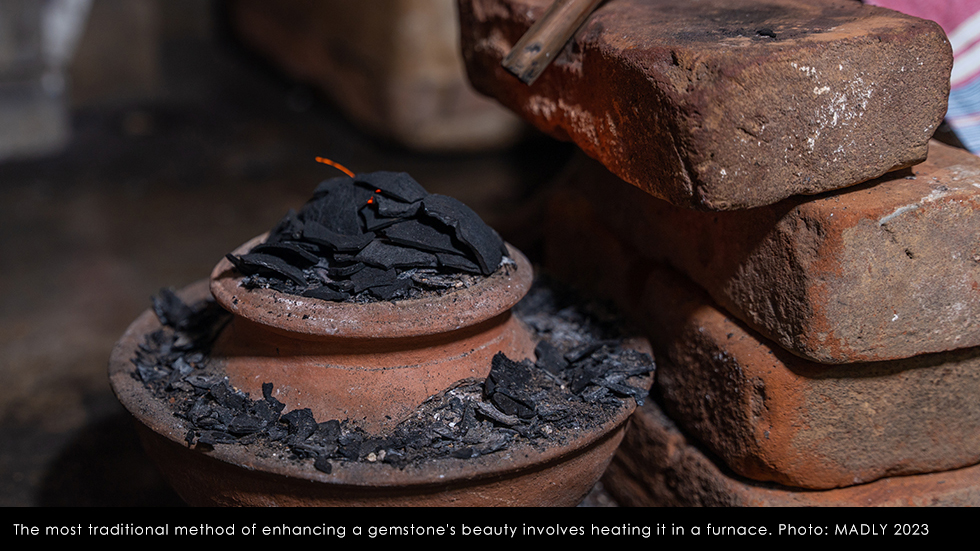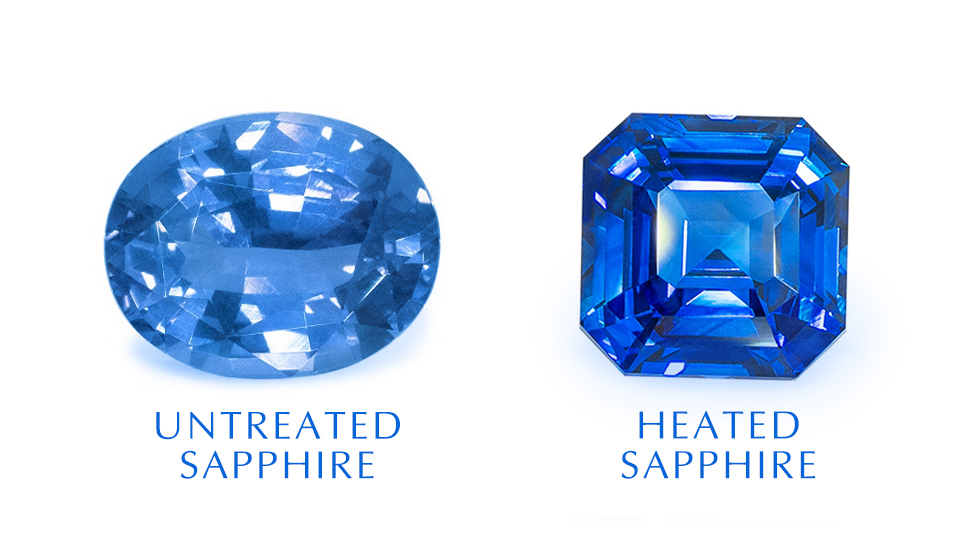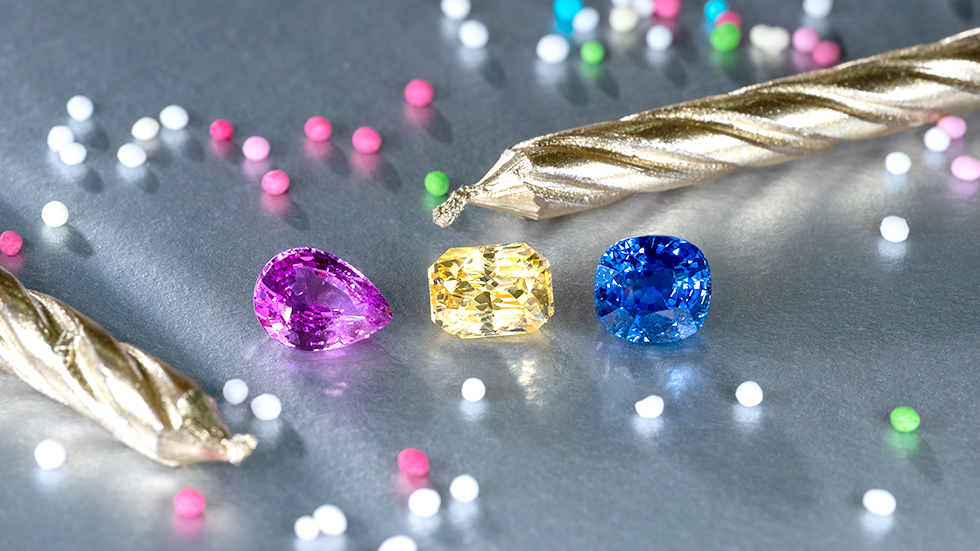Heated gemstones are those that have undergone heat treatment to enhance their colour, clarity, and even durability. This is a common practice in the gemstone industry, used on the vast majority of gemstones including Ruby, Sapphire, Aquamarine, Tourmaline, Topaz, Morganite, and more.

In fact, over 90% of these gemstones available in the market have undergone heat treatment – it’s practically a given! Notably, labs do not test for heat treatment on stones such as Zircon, Morganite, Tourmaline (with the exception of the Paraiba variety), and Aquamarine. Heat treatment has been practised for centuries to accentuate the beauty of gemstones. The most ancient method involves heating the gemstones in a furnace. This procedure can lighten, darken, deepen, or entirely change a gemstone’s hue. It can also eliminate inclusions, or worse, create them. Achieving a successful outcome requires a deep understanding of gemstones and their chemical makeup, along with a great deal of skill and precision.
An alternative view on heat treatment
I’d say a heat-treated gemstone is no less ‘natural’ than a woman who indulges in the occasional facial. The only difference is that a gemstone requires just one ‘treatment’ for a permanent enhancement!
I liken this widely accepted industry practice to a facial, which isn’t invasive like a surgical face lift! Think of it as mimicking the natural heat process happening in the ground over millions of years. The stone is still considered ‘natural’ without any foreign elements introduced into its mineral makeup.
What constitutes a natural stone?
The answer can vary depending on whom you ask, but here’s an interesting fact for you – just a few decades ago, gem labs only differentiated gemstones, such as Sapphires and Rubies, as natural or synthetic. The term ‘natural’ referred to both heated and untreated gemstones alike. Today, any treatment applied to the ‘big four’ stones, including heat treatment for Sapphire and Ruby, is explicitly indicated on their lab reports, often referred to as ‘certificates’. So, from my perspective, I’d say a heat-treated gemstone is no less ‘natural’ than a woman who indulges in the occasional facial. The only difference is that a gemstone requires just one ‘treatment’ for a permanent enhancement!
Are there any benefits to buying a heated gemstone?
Absolutely. Firstly, the heat treatment process can improve a gemstone’s colour and clarity, increasing its attractiveness, and consequently its appeal to buyers. This is particularly true for gemstones like the Ruby and Sapphire, which typically exhibit visible inclusions that can give the gem a somewhat cloudy or milky appearance.  You need to ask yourself if you’re willing to pay a premium – easily two or three times the price, for an untreated equivalent of a fine colour and good clarity. These rare specimens are the anomalies, not the norm. Therefore, if you’re working within a budget, a heated gemstone that captures your attention, wins your heart, and meets your requirements should not be dismissed! Heated gemstones also present a more sustainable option as they allow for the utilisation of gemstones that would otherwise be overlooked due to their less desirable colour or clarity. Only about 2% of gemstones mined are ‘gem quality’ without any treatment. However, with heat treatment, these stones can transform into captivating gemstones, reducing waste and boosting the supply of popular gemstones in the market i.e. ‘cornflower blue’ Sapphire or ‘vivid red’ Ruby… Furthermore, heated gemstones are often more affordable than unheated ones.
You need to ask yourself if you’re willing to pay a premium – easily two or three times the price, for an untreated equivalent of a fine colour and good clarity. These rare specimens are the anomalies, not the norm. Therefore, if you’re working within a budget, a heated gemstone that captures your attention, wins your heart, and meets your requirements should not be dismissed! Heated gemstones also present a more sustainable option as they allow for the utilisation of gemstones that would otherwise be overlooked due to their less desirable colour or clarity. Only about 2% of gemstones mined are ‘gem quality’ without any treatment. However, with heat treatment, these stones can transform into captivating gemstones, reducing waste and boosting the supply of popular gemstones in the market i.e. ‘cornflower blue’ Sapphire or ‘vivid red’ Ruby… Furthermore, heated gemstones are often more affordable than unheated ones.
Are there any potential drawbacks to buying a heated gemstone?
As long as the seller is transparent about the treatment at the point of sale, and the colour by heating is permanent (which it usually is), there is absolutely nothing wrong with opting for a heated alternative. No one is ever going to stop you on the streets to ask if the gem in your ring is heated or not! What will truly spark conversations is its colour, vibrancy, and brilliance.
Is an untreated gemstone more valuable than one that has been heated?
An untreated gemstone could potentially be more valuable than one that has been heated, but this is only the case when comparing two stones that are otherwise similar in their attributes. This concept is similar to ‘comparing apples with apples’ – the gemstones need to be comparable in terms of qualities like colour (hue, tone, saturation), weight, cut, clarity, origin and so on. For example, let’s take a ‘cornflower blue’ Sapphire. If you have a 5-carat untreated Sapphire and a 5-carat heated Sapphire, both with similar hue, tone, saturation, cut, clarity, and hailing from the same origin – the untreated Sapphire will generally be more valuable. This is because it achieved its desirable characteristics naturally, without the help of any enhancement methods. However, the comparison isn’t always this straightforward. Gemstones have a multitude of variables to consider, from their size/weight and shape/cut to their internal characteristics. So, comparing two gemstones, even of the same type, can be a complex task with many factors to take into account. This is why it’s important to understand that value isn’t determined solely by whether a gemstone is untreated or heated. It’s a combination of many different qualities that contribute to a gemstone’s overall value.
Colour is KING!
I cannot overstate that when it comes to coloured gemstones, colour reigns supreme! It is the paramount factor in grading coloured gemstones. Therefore, a heated gemstone with a vivid hue may indeed hold more value than an untreated one with a less desirable colour, assuming all other factors are equal. These are, after all, finite resources. Without heat-treated gemstones, the availability of gem-quality crystals in coveted colours would become even more scarce, leading to an exponential increase in gemstone prices.
Key takeaways to remember about heat-treated gemstones:
- Enhanced colour and clarity: Heat treatment can improve the colour and clarity of gemstones, enhancing their beauty.
- More sustainable: The heating of gemstones allows us to utilise gemstones that might otherwise be overlooked due to less desirable colour or clarity, contributing to a more sustainable gemstone industry.
- Affordability: More often than not, heated gemstones are more affordable than their unheated counterparts, making them a more budget-friendly choice.
Heating gemstones has nothing to do with whether the gem is genuine or not. Many consider the treatment as an extension of the natural process. What is important is to buy from a knowledgeable and reputable jeweller; one who offers a wide range of heated and untreated gemstones. This gives you the opportunity to compare, educate yourself, and make an informed decision.
Remember, a trustworthy jeweller will always provide full disclosure of any treatments applied to their gemstones at the point of sale.
